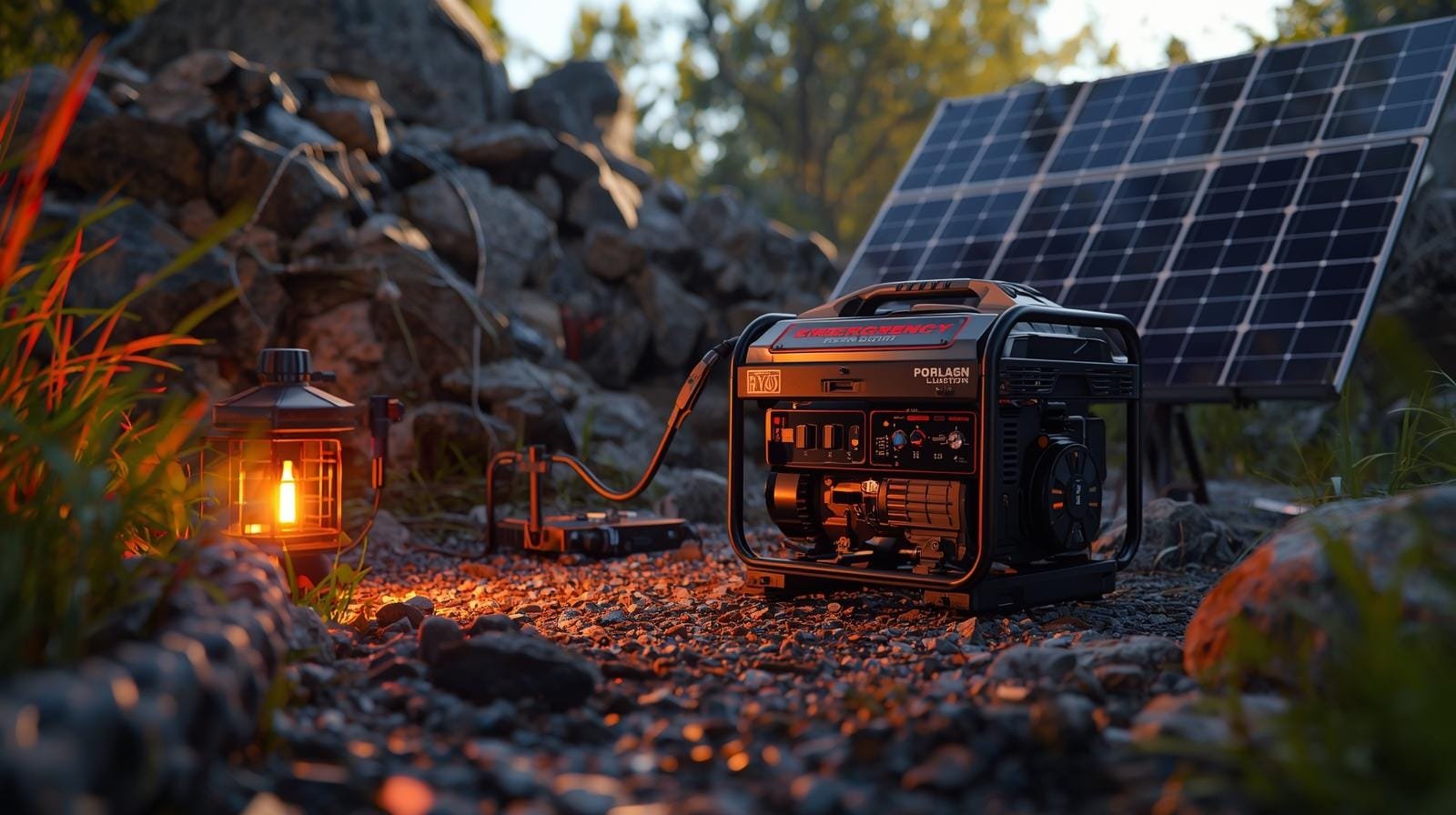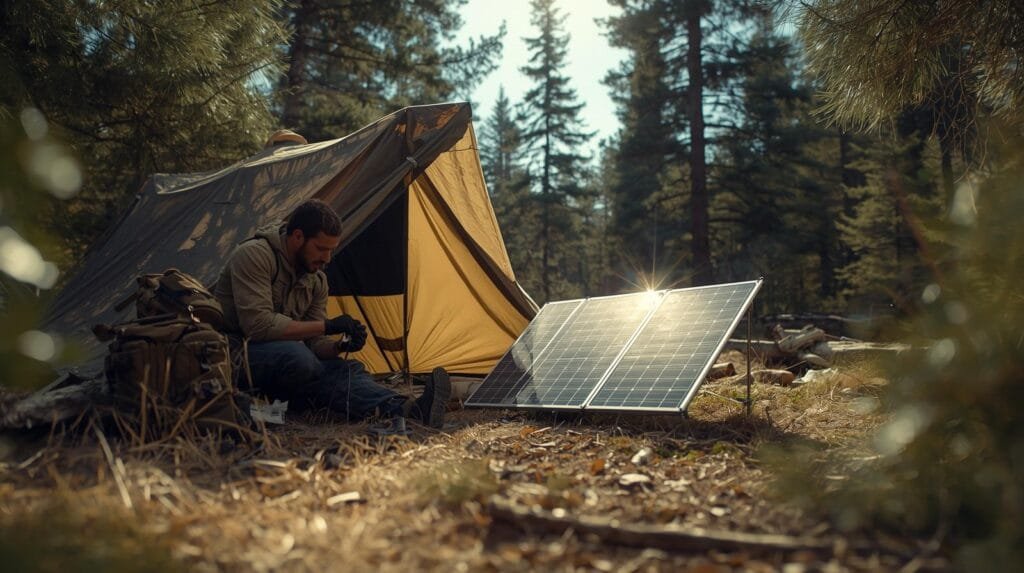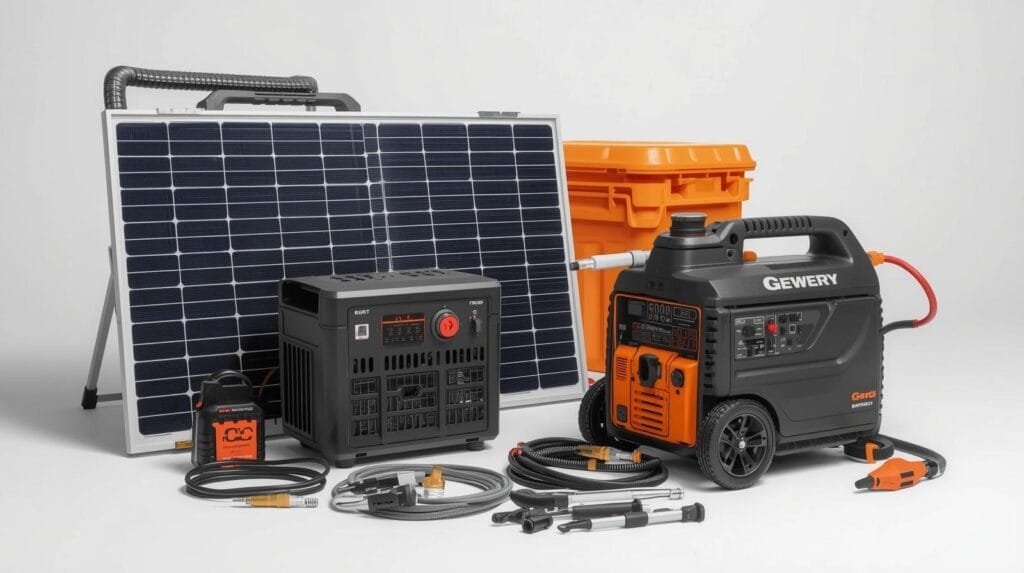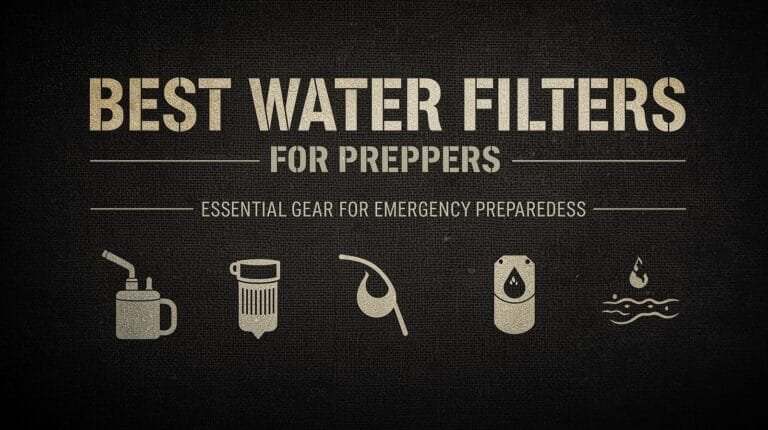
How To Use a Solar Generator for Prepping Without Wasting a Single Watt
Let’s be honest — if you’re relying on the grid during a crisis, you’re basically volunteering for chaos. But if you’ve got a solar generator? You’re one of the smart ones.
That said, plenty of preppers buy shiny new solar setups and then promptly use them like expensive paperweights. The good news? You don’t have to be that guy.
Learning how to use a solar generator for prepping means knowing how to pull every watt of power from the sun efficiently — charging the right gear, storing the right way, and avoiding rookie mistakes that waste power faster than a teenager scrolling TikTok on full brightness.
Let’s talk about turning sunlight into survival power — without wasting a single watt.
What Is a Solar Generator (and What It’s Not)
A solar generator for prepping is basically a battery system with built-in brains. It doesn’t make power; it collects, stores, and manages it from solar panels so you can charge and run your devices anytime.
Think of it as a quiet, fuel-free power plant that turns sunlight into survival juice.
A typical solar generator for prepping includes:
- Solar panels (to collect energy)
- Battery bank (to store it)
- Charge controller (to regulate input)
- Inverter (to convert DC to AC for normal appliances)
A charger is also an essential component for regulating the flow of energy into batteries, ensuring safe and efficient charging in off-grid or backup setups.
What it’s not:
- A magic infinite power source (you still need sunlight)
- A set-it-and-forget-it toy (maintenance matters)
- A full replacement for large fuel generators (unless you’ve got a serious setup)
According to the U.S. Department of Energy, understanding how solar energy works is the first step to maximizing your solar generator for prepping.
Why Solar Generators Matter for Preppers
When the grid dies, gas runs out, and the air smells faintly of panic, a solar generator for prepping quietly keeps working.
Top reasons preppers swear by solar generators:
- Fuel-free: no dependence on gas or propane
- Silent operation: you won’t announce your location with a roaring engine
- Renewable energy: as long as the sun rises, you’ve got power
- Low maintenance: just clean panels and smart charging
- Scalable: start small, expand over time
Solar generators provide reliable backup during power failure and power outages, ensuring essential devices remain operational in emergencies.
The National Renewable Energy Laboratory (NREL) confirms that photovoltaic systems provide reliable off-grid power when properly sized and maintained. In other words, it’s power independence — without the fumes or noise.
The Benefits of Renewable Energy for Preppers

When it comes to prepping, having a reliable source of power isn’t just a luxury—it’s a lifeline. That’s where renewable energy, especially solar power, steps in as a prepper’s best friend. Solar generators and solar panels offer a sustainable, fuel-free way to keep your essential devices running, whether you’re facing a short-term blackout or a full-blown SHTF situation.
Why go solar? For starters, solar generators don’t rely on gas or propane, so you’re not at the mercy of empty fuel stations or skyrocketing prices. With a well-designed solar system, you can power a few lights, keep your cell phones and laptops charged, and even run a well pump or power tools—all without worrying about running out of fuel. Portable solar panels make it easy to set up wherever you are, whether you’re bugging in or out.
One of the biggest perks of solar power is backup power during emergencies. When the grid goes down, a solar generator can keep your small batteries, radios, and medical devices powered for multiple days. Need to keep a mini fridge running or charge phones for the whole house? With the right capacity and enough panels, your solar system has you covered. And with a transfer switch, you can seamlessly switch between grid and solar power, so you’re never left in the dark.
Battery choice matters, too. While lead acid batteries (like deep cycle acid batteries) have been the go-to for years, they require regular maintenance and have a limited lifespan. Newer lithium-ion options, like those found in the Grid Doctor 3300 and other solar generators with good reviews, offer longer life, less hassle, and more efficient energy storage. That means more reliable power for your devices and less time worrying about battery upkeep.
Let’s not forget the financial and environmental benefits. By generating your own electricity from the sun, you can slash your electric bill and reduce your reliance on the grid. Every watt you produce is one less you have to buy, and over a couple years, those savings add up. Plus, using solar panels and solar generators helps lower your carbon footprint—a win for both your wallet and the world.
In a true emergency, solar power can be a game-changer. Whether you need to keep communication lines open, run medical equipment, or power water purification systems, a solar generator gives you the flexibility and independence you need. And because solar systems are modular, you can start small and expand as your needs (and budget) grow—just add more panels or a bigger battery when you’re ready.
Before you buy, do your homework. Read reviews, compare models, and talk to other preppers to find the ideal system for your situation. Look for solar generators and panels with proven reliability, solid capacity, and features that match your needs—like a transfer switch for easy grid integration or a power inverter for running AC devices.
Bottom line: Renewable energy, especially solar power, is a smart investment for any prepper. It delivers reliable backup power, reduces your dependence on gas generators and the grid, and helps you stay prepared for whatever the future throws your way. With the right solar system, you’ll be ready to power through emergencies, save money, and protect the planet—all at the same time.
Step-by-Step: How To Use a Solar Generator for Prepping

Step 1: Position Your Solar Panels Like a Pro
Your solar generator for prepping is only as good as the sunlight it captures. Panels need direct sunlight, not shade. Using a portable solar panel allows for flexible placement and easy repositioning to maximize sun exposure in changing conditions.
Here’s how to position them correctly:
- Face them south (in the Northern Hemisphere) or north (in the Southern Hemisphere)
- Tilt them at 30–45° depending on your latitude and season
- Avoid shadows from trees, buildings, or other obstructions
- Keep them clean — even a little dust can cut output by 20%
The National Renewable Energy Laboratory provides detailed guidance on optimal solar panel positioning for maximum energy production.
🪶 Pro Tip: A $20 folding panel brush beats a dirty rag every time. Clean panels = more power.
Step 2: Charge Your Solar Generator the Right Way
Always use your solar generator for prepping’s dedicated charge controller. Plugging solar panels directly into the battery is a one-way ticket to “smoke signals instead of electricity.”
Follow these charging rules:
- Match panel voltage to your generator’s specifications
- Never exceed input wattage limits
- Use proper MC4 connectors for secure connections
- Monitor charging status through your generator’s display
Always keep your solar generator fully charged to ensure it’s ready for emergencies.
If your unit supports daisy-chaining panels, match voltages carefully — and never exceed your generator’s input wattage. Batteries should be recharged regularly to maintain optimal performance and longevity.
Example: A Jackery 1000 can handle 200W of input max. Two 100W panels = perfect. Four panels = melted dreams.
Step 3: Prioritize What You Power (The Critical List)
Don’t try to run your entire household. A solar generator for prepping shines when powering essentials, not excess. Solar generators are ideal for powering small stuff, such as charging phones, running lights, and other minor electronics.
Power these first (Priority 1):
- Radios, phones, GPS units (including charging phones)
- LED lanterns and flashlights
- Rechargeable AA/AAA batteries
- Critical medical devices (CPAPs, nebulizers)
Secondary items (Priority 2):
- Mini-fridges for medications or food
- Fans for heat management
- Laptops for communication
- Computer for uninterrupted backup power during outages
- Water purifiers
Avoid wasting power on:
- Hair dryers
- Microwaves
- Electric kettles
- Space heaters
- Coffee makers(well maybe not this)
Rule of thumb: If it hums, heats, or blinks fancy lights — it’s probably not worth your watts.
Step 4: Store Energy Smartly (Battery Management 101)
Think of your solar generator for prepping’s battery capacity as water in a tank — once it’s full, any extra sun goes to waste unless you use it or store it. Understanding your system’s load is crucial for effective battery management, as higher loads will drain the battery faster.
Smart energy storage strategy:
- Run power-hungry devices during daylight when panels are actively producing
- Use stored energy for nighttime essentials only
- Add an expansion battery for larger setups
- Keep batteries between 20–80% charge for maximum lifespan
- Monitor your power supply to ensure you have enough stored energy for essential devices during nighttime or cloudy periods
According to Battery University, maintaining proper charge levels significantly extends lithium battery life.
🔋 Affiliate Tip: Check out the Bluetti AC200P or EcoFlow Delta Pro — both beasts in the solar generator for prepping world.
Step 5: Rotate and Maintain Your Power System
Just like food storage, your solar generator for prepping needs regular attention to stay mission-ready.
Monthly maintenance checklist:
- ✅ Recharge fully, even if unused
- ✅ Check all connections for tightness
- ✅ Inspect cables for frays, cracks, or moisture damage
- ✅ Clean panel surfaces with soft cloth and water
- ✅ Test inverter output with small device
- ✅ Store panels inside during storms or high winds
- ✅ Update firmware if applicable (newer models)
- ✅ Watch your system’s power usage and battery levels regularly to catch issues early and optimize performance
Think of your solar generator for prepping as your silent sentry — it can’t protect you if it’s neglected.
Power Management Tips: Squeeze Every Watt
You wouldn’t waste ammo. Don’t waste watts from your solar generator for prepping.
Here’s how to stretch your power like a pro:
1. Use DC power when possible. It’s 10-15% more efficient than converting to AC through the inverter.
2. Run devices in order of priority. Lights > comms > comfort. Always.
3. Invest in low-draw gear. LED everything. Modern LED bulbs use 75% less energy than traditional bulbs.
4. Charge during peak sun hours. That’s typically 10 AM–3 PM when panels produce maximum output.
5. Keep batteries in optimal range. Between 20–80% charge extends battery life significantly.
6. Unplug vampire loads. Even when “off,” some devices draw phantom power through the inverter.
7. Estimate your backup duration. Calculate how long your solar generator can run essential devices for a few hours during an outage, and plan your usage accordingly.
Efficient power management not only keeps your essentials running but also leads to significant energy saving, reducing both resource consumption and costs during emergencies.
🌞 Field Wisdom: Treat every watt from your solar generator for prepping like a resource. Once it’s gone, it’s gone until sunrise.
Must-Have Accessories for Your Solar Generator Setup
Here’s the gear that turns your solar generator for prepping from “meh” to “mission-ready”:
| Gear | Why You Need It | Recommended Pick |
|---|---|---|
| Folding Solar Panels | Lightweight, portable power anywhere | Jackery SolarSaga 100W |
| Extension Cables | Keep panels in the sun while generator stays shaded | ALLPOWERS 20ft MC4 Cable Kit |
| Power Splitter/Combiner | Chain multiple panels safely | Renogy Branch Connectors |
| Battery Expansion Pack | Increase runtime overnight | EcoFlow Extra Battery Module |
| Power Station | Core of your system | Bluetti AC200P / EcoFlow Delta Pro |
| EMP Protection Bag | Shield electronics from solar flares/EMP | Mission Darkness TitanRF Faraday Bag |
💬 Affiliate CTA: Check prices and specs on Amazon — because the apocalypse won’t wait for a restock.
Sizing Your Solar Generator for Prepping: Math That Actually Matters
Here’s where most people’s eyes glaze over faster than a donut shop window. But stick with me — because buying the wrong-sized solar generator for prepping is like showing up to a gunfight with a Nerf blaster. Technically it shoots, but you’re not winning. Choosing the right size solar generator is especially important for maintaining power during an extended outage, ensuring your essential devices and appliances keep running.
Calculate Your Actual Power Needs (Not Your Fantasy Ones)
Everyone thinks they need a 3000Wh beast. Most people actually need about 1000Wh. The difference? Honesty about what you’ll actually use versus what you think you might possibly maybe use if aliens invade and you need to power a disco ball.
Here’s the reality check formula:
- List your essential devices (be brutal about what’s actually essential)
- Find their wattage (check labels or Google “[device] power consumption”)
- Estimate daily runtime (in hours)
- Multiply watts × hours for each device
- Add everything up and multiply by 1.3 (for inefficiency buffer)
Example: A realistic 24-hour emergency scenario
- LED lantern (10W × 8 hours) = 80Wh
- Phone charging (10W × 2 hours) = 20Wh
- Radio (5W × 4 hours) = 20Wh
- Laptop (60W × 3 hours) = 180Wh
- Mini fridge (50W × 12 hours) = 600Wh
- Total: 900Wh × 1.3 = 1,170Wh needed
Boom. You need a 1000-1500Wh solar generator for prepping, not that shiny 3000Wh unit that costs more than your first car.
The Three Tiers of Solar Generator Setups
Think of solar generator for prepping setups like pizza sizes. Small, medium, and “are you feeding a small army?”
Tier 1: The Weekend Warrior (300-500Wh)
- Best for: Bug-out bags, camping, minimal electronics
- Powers: Phones, lights, radios, small medical devices
- Solar panels needed: 1-2 × 100W panels
- Cost: $300-$600
- Honest assessment: Great for mobility, terrible for comfort. You’re surviving, not thriving.
Tier 2: The Sweet Spot (1000-1500Wh)
- Best for: Most preppers, extended outages, small families
- Powers: Everything in Tier 1, plus laptop, mini fridge, fan, water purifier
- Solar panels needed: 2-3 × 100W panels
- Cost: $1,000-$1,800
- Honest assessment: This is where 80% of preppers should live. Enough power to stay functional without breaking the bank.
Tier 3: The Homestead Hero (2000Wh+)
- Best for: Long-term off-grid, families, medical needs, running small appliances
- Powers: Multiple devices simultaneously, power tools, larger fridges, washing machines (briefly)
- Solar panels needed: 4-6 × 100W panels (or larger panels)
- Cost: $2,000-$5,000+
- Honest assessment: You’re basically running a small power company. Expensive but worth it if you’re serious about independence.
Expandability: Why Starting Small Makes Sense
Here’s a dirty little secret the solar industry doesn’t advertise: you don’t need to buy everything at once. In fact, you probably shouldn’t.
A quality solar generator for prepping with expandability means you can start with the basics and grow your system as your budget (and paranoia level) increases.
The smart growth path:
- Start: Buy a 1000-1500Wh power station + 200W of panels
- Month 3: Add another 100-200W of panels
- Month 6: Add an expansion battery
- Month 12: Add specialty gear (DC appliances, more efficient devices)
This approach lets you learn the system without dropping $5K upfront on gear you might use wrong anyway. Plus, technology improves fast — that expansion battery you buy in six months will probably be better and cheaper than today’s version.
Weather, Seasons, and Solar Reality Checks

Let’s talk about the elephant in the room: the sun doesn’t always cooperate with your survival plans.
Cloudy Day Performance (The Harsh Truth)
Your solar generator for prepping on a cloudy day produces about 10-25% of its rated capacity. On a really cloudy day, you might as well be trying to charge it with optimism and good vibes.
Cloudy day strategy:
- Plan for 20% efficiency on overcast days
- Increase your panel array by 3-4× if you live in Seattle or other gloomy locations
- Build extra battery capacity for multi-day cloudy stretches
- Have backup charging methods (car adapter, hand crank, wall outlet while grid is up)
Fun fact: Minnesota in January is not solar paradise. If you’re prepping for winter emergencies in the north, you need either massive panel arrays or realistic expectations. Possibly both, plus whiskey.
Seasonal Adjustments (Sun Angles Are Real)
The sun’s position changes throughout the year, and your panels need to change with it — or you’re leaving power on the table.
Summer: Panel angle around 15-30° (flatter) Winter: Panel angle around 45-60° (steeper) Spring/Fall: Panel angle around 30-45° (middle ground)
Or just remember: Latitude minus 15° in summer, latitude plus 15° in winter. If you live at 40° latitude (roughly Colorado), that’s 25° in summer and 55° in winter.
Yeah, I know. Math. But it’s the difference between charging in 4 hours versus 8 hours. Your choice.
Temperature Effects Nobody Mentions
Cold batteries charge slower. Hot batteries degrade faster. Welcome to physics, where everything has trade-offs.
Cold weather tips:
- Keep your solar generator for prepping indoors when not in use
- Panels actually perform better in cold weather (more efficient)
- Batteries charge slower but still work down to about -4°F (most lithium systems)
Hot weather tips:
- Don’t leave your generator in direct sun (panels in sun, unit in shade)
- Batteries degrade faster above 85°F during storage
- Charge capacity drops temporarily in extreme heat (it comes back when cooler)
The National Renewable Energy Laboratory has done extensive research on temperature effects on solar systems. Spoiler: temperature matters more than most people think.
DC vs AC: The Efficiency War Nobody’s Winning
Every time you convert DC battery power to AC household power, you lose about 10-15% to inefficiency. It’s like a electricity tax you pay for convenience.
Here’s the efficiency breakdown:
- DC to DC: ~95% efficient (nearly perfect)
- DC to AC (through inverter): ~85-90% efficient (wasteful but necessary for most stuff)
- AC to DC (like phone chargers): Another ~85% loss (now you’re just being silly)
The DC Appliance Revolution
Smart preppers are switching to DC-powered versions of common devices. Why? Because using DC for your solar generator for prepping eliminates that conversion loss entirely.
DC alternatives worth considering:
- DC refrigerators (like ARB or Dometic) — use 50-60% less power than AC fridges
- 12V fans — way more efficient than AC fans
- USB devices — already DC, just skip the AC adapter
- 12V water pumps — for off-grid water systems
- DC LED lighting — uses a fraction of the power
Yes, these cost more upfront. But they also mean your solar generator for prepping runs 30-50% longer on the same battery. That’s the difference between three days of power and two days. Math wins again.
Protecting Your Investment: EMP, Surge, and Murphy’s Law
You’ve spent good money on a solar generator for prepping. Now let’s make sure it survives the very disasters you’re preparing for.
EMP and Solar Flare Protection (The Paranoid Prepper’s Dilemma)
Will your solar generator for prepping survive an EMP or massive solar flare? Maybe. The battery and panels probably will. The charge controller and inverter? Less certain. Those delicate electronics don’t love electromagnetic pulse events.
Protection options:
- Faraday cage storage when not in use (Mission Darkness bags work great)
- Store spare charge controllers in Faraday protection
- Keep one complete backup system in EMP protection
- Accept that panels themselves are pretty EMP-resistant (just thick glass and silicon)
Is this overkill? Maybe. But you’re reading an article about solar generator for prepping, so clearly rational risk assessment isn’t your strong suit anyway. Join the club.
Surge Protection (The Boring But Essential Stuff)
Lightning strikes. Power surges. Cosmic rays. Okay, probably not cosmic rays, but definitely the first two.
Protect your solar generator for prepping with:
- Built-in surge protection (most quality units have this)
- Lightning arrestors for panel arrays
- Grounding your metal panel frames
- Disconnecting during electrical storms (be conservative)
One lightning strike can turn your expensive solar setup into modern art. Expensive, non-functional modern art.
Common Mistakes That Waste Power (And How to Fix Them)
If your solar generator for prepping isn’t pulling its weight, odds are one of these culprits is to blame:
❌ Mistake #1: Panels Not Angled Correctly****Fix: Adjust panel tilt seasonally. Steeper in winter, shallower in summer. Half your watts are lost to bad positioning.
❌ Mistake #2: Running Everything Through AC****Fix: Use DC outputs whenever possible. AC conversion loses 10-15% efficiency every time.
❌ Mistake #3: Letting Batteries Fully Drain****Fix: Recharge when battery hits 20%. Deep discharges dramatically shorten lifespan.
❌ Mistake #4: Storing Panels Dirty or Wet****Fix: Clean and dry panels before storage. Moisture + electronics = expensive sadness.
❌ Mistake #5: Charging at Night****Fix: Yes, people actually try this. Don’t be that person. Solar panels need sunlight.
❌ Mistake #6: Ignoring Temperature Effects****Fix: Extreme heat or cold affects battery performance. Store your solar generator for prepping in moderate temperatures when possible.
❌ Mistake #7: Relying Solely on a Gas Generator
Fix: While a gas generator can provide immediate backup power during emergencies or outages, it depends on fuel availability. In long-term situations or fuel shortages, a solar generator is more reliable and sustainable. Use a gas generator as a supplement, not your only solution.
Fix these mistakes, and you’ll instantly see your solar generator for prepping’s performance jump.
Quick Reference: Power Consumption Guide
Understanding how much power common devices use helps you manage your solar generator for prepping efficiently:
| Device | Average Watts | Runtime on 1000Wh Battery |
|---|---|---|
| LED Light (10W) | 10W | 100 hours |
| Smartphone Charge | 5-10W | 100+ charges |
| Laptop | 50-75W | 13-20 hours |
| Mini Fridge – If you’re preparing for emergencies, you might also want to consider investing in the best emergency radios for preppers to stay informed during grid-down situations. | 40-100W | 10-25 hours |
| CPAP Machine | 30-60W | 16-33 hours |
| Ham Radio | 5-50W | 20-200 hours |
| Fan | 10-50W | 20-100 hours |
| Electric Blanket | 50-200W | 5-20 hours |
The Solar Energy Industries Association provides additional resources on calculating solar power needs for off-grid applications.
Wrapping Up & My Experience
I’ve used a solar generator for prepping in everything from Ozark thunderstorms to week-long grid outages. The gear never failed — but people often did, by using it wrong.
Once you learn how to manage sunlight like currency, you’ll realize a solar generator for prepping isn’t just a backup plan — it’s freedom in watts.
So, whether you’re bugging out, camping, or riding out the next blackout, remember this: Every watt counts. Don’t waste them — wield them.
A properly managed solar generator for prepping can provide reliable power for weeks or even months without fuel resupply. Master these techniques, and you’ll have true energy independence when it matters most.
Related Reads:
This article is your comprehensive prepper’s guide to using solar generators for emergency preparedness.
- Solar Generators vs Gas Generators: Which Should You Trust When the Grid Dies? (Coming soon)
- Crucial Water Storage for Preppers: Proven Ways to Stay Hydrated When the Grid Goes Dark
- Best Off-Grid Heating Solutions for Winter 2025 (Silent, Safe, and Fuel-Free) (Also Coming soon)
Additional Resources:
- U.S. Department of Energy – Solar Basics
- NREL – Photovoltaic Research
- Battery University – Battery Care
- Solar Energy Industries Association
- 10 Best Self Reliance Outfitters Gear Picks for Preppers 2025
Remember: Your solar generator for prepping is an investment in independence. Treat it right, and it’ll serve you faithfully when the lights go out.
Heads-Up, Fellow Preppers:
Some links in this post are sponsored or affiliate links. If you click and buy, I may earn a small commission—enough to restock my peanut butter and maybe add one more can of chili to the stash. I only recommend gear I trust, use, and would hide in a bug-out bag.






